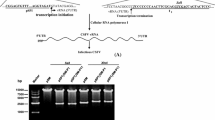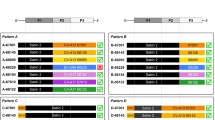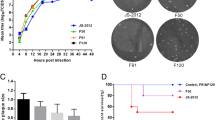Summary
We studied in vivo recombination between a thymidine kinase (TK) negative, glycoprotein E (gE) negative, attenuated strain and a virulent strain of pseudorabies virus (PRV) in pigs. To simplify the detection of recombination we inserted different but overlapping (375 bp) parts of the E1 gene of classical swine fever virus into the gG locus of both virus strains. Recombination between the E1 sequences of these viruses results in reconstitution of the complete E1 coding sequence and expression of the E1 protein. Since E1 is highly immunogenic, we expected to detect in vivo recombination in co-inoculated pigs by the presence of serum antibodies against E1. However, after co-inoculation of pigs with high doses of both virus strains, we were unable to detect antibodies against E1, suggesting that in vivo recombination did not occur or remained below the detection limit. Analysis of individual progeny viruses showed that 13 out of 995 (1.3%) possessed a recombinant TK-negative gE-positive phenotype. In contrast, no E1-positive viruses were detected among 5000 analyzed. This result showed that in vivo recombination between the two virus strains did occur, but was much more frequent between the TK and gE loci than between the E1 sequences. Similar results were obtained in in vitro recombination experiments in which possible growth differences between the various virus strains were excluded. The different recombination frequencies could not be attributed to the difference in distance of the genetic loci since recombination between mutations at a distance of 266 bp in the TK gene occurred as frequent as recombination between the TK and gE genes which are separated by approximately 60 kilobasepairs. These results indicate that some property of the E1 sequence and/or the location of the E1 sequence within the PRV genome affects the frequency of recombination.
Similar content being viewed by others
References
Baskerville A, MC Ferran JB, Dow C (1973) Aujeszky's disease in pigs. Vet Bull 43: 465–480
Brochier BM, Languet B, Blancou J, Kieny MP, Lecocq JP, Costy F, Desmettre P, Pastoret P-P (1989) Use of recombinant vaccinia-rabies virus for oral vaccination of fox cubs (Vulpes vulpes, L) against rabies. Vet Microbiol 18: 103–108
Christensen LS, Lomniczi B (1993) High frequency intergenomic recombination of suid herpesvirus 1 (SHV-1, Aujeszky's disease virus). Arch Virol 132: 37–50
Dangler CA, Henderson LM, Bowman LA, Deaver RE (1993) Direct isolation and identification of recombinant pseudorabies virus strains from tissues of experimentally co-infected swine. Am J Vet Res 54: 540–545
Fathi Z, Dyster LM, Seto J, Condit RC, Niles EG (1991) Intragenic and intergenic recombination between temperature-sensitive mutants of vaccinia virus. J Gen Virol 72: 2733–2737
Gielkens ALJ, Van Oirschot JT, Berns AJM (1985) Genome differences among field isolates and vaccine strains of pseudorabies virus. J Gen Virol 66: 69–82
Glazenburg KL, Elgersma-Hooisma M Briaire J, Voermans J, Kimman TG, Gielkens ALJ, Moormann RJM (1994) Vaccine properties of pseudorabies virus strain 783 are not affected by a deletion of 71 base pairs in the promoter/enhancer region of the viral immediate early gene. Vaccine 12: 1097–1100
Glazenburg KL, Moormann RJM, Kimman TG, Gielkens ALJ, Peeters BPH (1994) In vivo recombination of pseudorabies virus in mice. Virus Res 34: 115–126
Henderson LM, Katz JB, Erickson GA, Mayfield JE (1990) In vivo and in vitro genetic recombination between conventional and gene-deleted vaccine strains of pseudorabies virus. Am J Vet Res 51: 1656–1662
Henderson LM, Levings RL, Davis AJ, Sturtz DR (1991) Recombination of pseudorabies virus vaccine strains in swine. Am J Vet Res 52: 820–825
Hruby DE (1990) Vaccinia virus vectors: new strategies for producing recombinant vaccines. Clin Microbiol Rev 3: 153–170
Jamieson AT, Gentry GA, Subak-Sharpe JH (1974) Induction of both thymidine and deoxycytidine kinase activity by herpes viruses. J Gen Virol 24: 465–480
Javier RT, Sedarati F, Stevens JC (1986) Two avirulent herpes simplex viruses generate lethal recombinants in vivo. Science 234: 746–748
Kasza L, Shadduck JA, Christofinis GJ (1972) Establishment, viral susceptibility, and biological characteristics of a swine kidney cell line SK-6. Res Vet Sci 13: 46–51
Katz JB, Henderson LM, Erickson GA (1990) Recombination in vivo of pseudorabies vaccine strains to produce new virus strains. Vaccine 8: 286–288
Kimman TG (1992) Risks connected with the use of conventional and genetically engineered vaccines. Vet Q 15: 110–118
Kit M, Kit S, Little SP, Di Marchi RD, Gale C (1991) Bovine herpesvirus-1 (infectious bovine rhinotracheitis virus)-based viral vector which expresses foot-and-mouth disease epitopes. Vaccine 9: 564–572
Moormann RJM, De Rover T, Briaire J, Peeters BPH, Gielkens ALJ, Oirschot JT (1990) Inactivation of the thymidine kinase gene of a gI deletion mutant of pseudorabies virus generates as safe but still highly immunogenic vaccine strain. J Gen Virol 71: 1591–1595
Mulder WAM, Priem J, Glazenburg KL, Wagenaar F, Gruys E, Gielkens ALJ, Pol JMA, Kimman TG (1994) Virulence and pathogenesis of non-virulent and virulent strains of pseudorabies virus expressing envelope glycoprotein E1 of hog cholera virus. J Gen Virol 75: 117–124
Nishiyama Y, Kimura H, Daikoku T (1991) Complementary lethal invasion of the central nervous system by non-neuroinvasive herpes simplex virus type 1 and 2. J Virol 65: 4520–4524
Peeters B, Bouma A, de Bruin T, Moormann R, Gielkens A, Kimman T (1994) Non transmissible pseudorabies virus gp50 mutants: a new generation of safe live vaccines. Vaccine 12: 375–380
Pensaert MB, Kluge JP (1989) Pseudorabies virus (Aujeszky's disease). In: Pensaert MB (ed) Virus infection of porcines. Elsevier, Amsterdam, pp 39–64
Sambrook J, Fritsch EF, Maniatis T (1989) Molecular cloning: a laboratory manual. Cold Spring Harbor Laboratory Press, Cold Spring Harbor
Tenser RB, Jones JC, Ressel SJ, Fralish FA (1983) Thymidine plaque autoradiography of thymidine kinase-positive and thymidine kinase-negative herpesviruses. J Clin Microbiol 17: 122–127
Van Oirschot JT, Terpstra C, Moormann RJM, Berns AJM, Gielkens ALJ (1990) Safety of an Aujeszky's disease vaccine based on deletion mutant strain 783 which does not express thymidine kinase and glycoprotein I. Vet Rec 127: 443–446
Van Oirschot JT, Moormann RJM, Berns AJM, Gielkens ALJ (1991) Efficacy of a pseudorabies virus vaccine based on deletion mutant strain 783 that does not express thymidine kinase and glycoprotein I. Am J Vet Res 52: 1056–1060
Van Rijn PA, van Gennip HGP, de Meijer EJ, Moormann RJM (1993) Epitope mapping of the envelope glycoprotein E1 of hog cholera virus strain Brescia. J Gen Virol 74: 2053–2060
Van Zijl M, Wensvoort G, De Kluyver E, Hulst M, Van der Gulden H, Gielkens A, Berns A, Moormann R (1991) Live attenuated pseudorabies virus expressing envelope glycoprotein E1 of hog cholera virus protects swine against both pseudorabies and hog cholera. J Virol 65: 2761–2765
Visser N, Lütticken D (1989) Experiences with a gI−/TK− modified live pseudorabies virus vaccine: strain Begonia. Proceedings of the CEC seminar on vaccination and control of Aujeszky's disease. Kluwer, Dordrecht, pp 37–44
Wensvoort G, Terpstra C, Boonstra J, Bloemraad M, van Zaane D (1986) Production of monoclonal antibodies against swine fever and their use in laboratory diagnostics. Vet Microbiol 12: 101–108
Wensvoort G, Bloemraad M, Terpstra C (1988) An enzyme immunoassay, employing monoclonal antibodies, and detecting specifically antibodies against classical swine fever virus. Vet Microbiol 17: 129–140
Author information
Authors and Affiliations
Rights and permissions
About this article
Cite this article
Glazenburg, K.L., Moormann, R.J.M., Kimman, T.G. et al. Genetic recombination of pseudorabies virus: evidence that homologous recombination between insert sequences is less frequent than between autologous sequences. Archives of Virology 140, 671–685 (1995). https://doi.org/10.1007/BF01309957
Received:
Accepted:
Issue Date:
DOI: https://doi.org/10.1007/BF01309957




